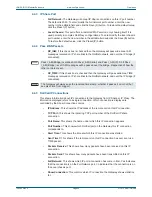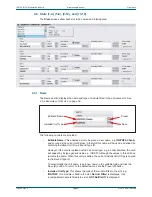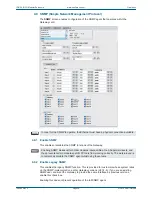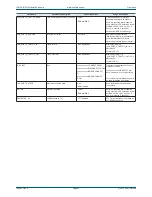
IQH3A IQ 3U Modular Enclosure
www.snellgroup.com
Operation
Issue 2 Rev 2
Page 60
©
2014 Snell Limited
4.9.3 Read community
Configures the SNMP read community value. Default value “public”.
4.9.4 MIB2 sysContact
Customer given name of person responsible for equipment.
4.9.5 MIB2 sysLocation
Customer given physical or logical location of system.
4.9.6 Write community
Configures the SNMP write community value. Default value “private”.
4.9.7 MIB2 sysName
Name of system if applicable.
4.9.8 Read Write Port
TCP/IP port number (range:1-65535) used in all SET and GET SNMP operations. Default is
161. The SNMP manager should match this value to operate correctly.
4.9.9 Resend All Traps
Resends all current traps/notifications for all occupied slots and Gateway card. If legacy
operation is enabled, the associated traps are also sent.
4.9.10 Traps
The Gateway supports up to eight trap destinations. Each entry must be unique, unless IP
trap address is set to 0.0.0.0. For each trap the user can configure:
•
IP address:
The IP address, format nnn.nnn.nnn.nnn, to which notifications (traps)
are sent. This address should correspond to the IP address of the PC monitoring
notifications.
•
Port:
The connection port address used to send notifications. The target machine (IP
address) should be configured to “listen” for notifications on this port. The SNMP
default is 162, but other port numbers may be used.
•
Community:
Trap Community string. This string is included within the SNMP trap
message.
•
Enable:
Enable this Trap destination. Trap dest 1 is always enabled when SNMP is
enabled, so it has no enable control.
4.9.11 Slot Trap Enable
With SNMP enabled, these controls allow filtering of trap messages from individual slot
positions, or even the Gateway. Trap sending is only available when control is enabled for the
slot. See
SNMP Control
below.
4.9.12 SNMP Control
These check boxes allow filtering of SNMP control to only the desired slots / gateway. If traps
are required on a slot, control must also be enabled.
Note:
Changing this value restarts the SNMP agent.













































